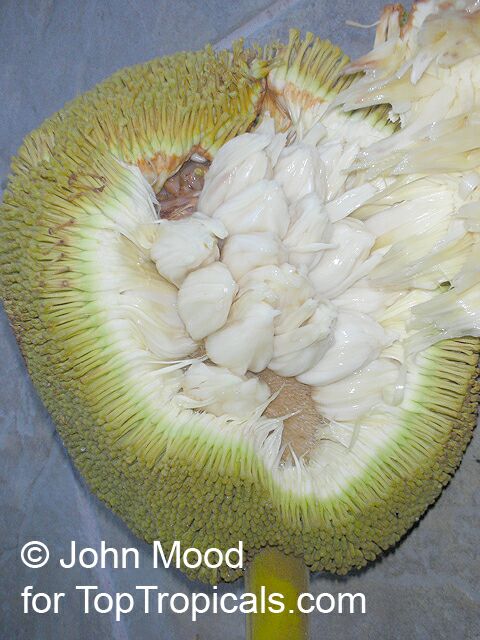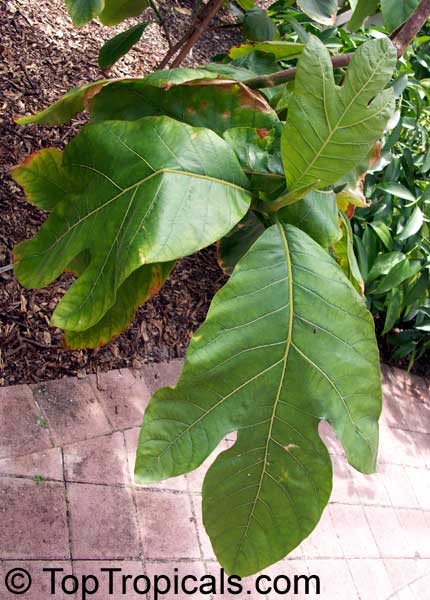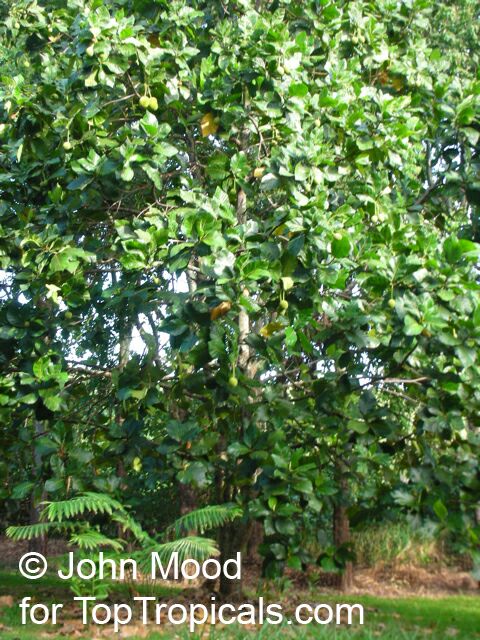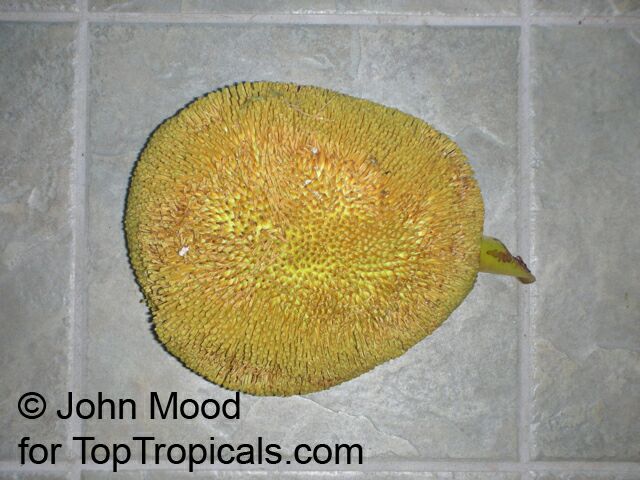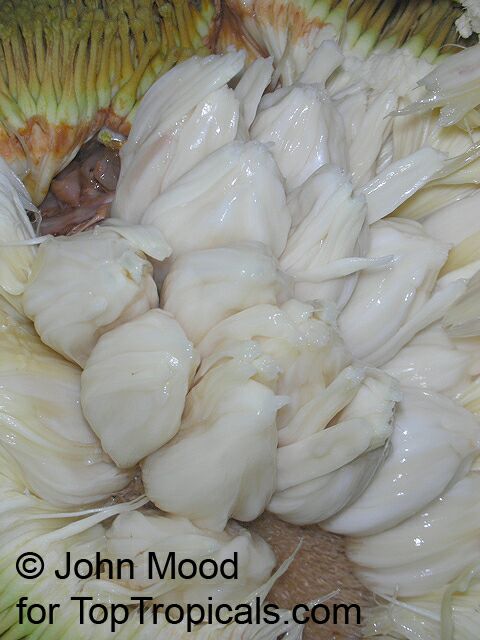Featured plant - a special for your collection
Artocarpus odoratissimus - heavenly delicious fruit
Scientific name: Artocarpus odoratissimus
Family: Moraceae
Common names: Marang, Tarap, Green Terap, Johey Oak
Origin: Malesia, Borneo, Brunei
Marang, or Tarap, is one of the most delicious tropical fruit and beautiful exotic tree. It has lobed leaves, as large as 2-4ft long and 1 ft broad, similar to the Breadfruit's, but a little less lobed. It is native to Southeastern Asia. In a wild, is found extensively in Brunei Darussalam and parts of Sabah and Sarawak.
Fruit
As indicated by the scientific name, the fruit has a strong scent. It is delicious, soft flavored and can be appreciated from the first bite. The fruit is considered superior in flavor to both Jackfruit or Chempedak. It is oblong, 10-12" long, and can weight up to a few pounds. The appearance of the fruit can be regarded as an intermediate shape between the Jackfruit and the Breadfruit. The fruit color turns from a light green to a deep shade of brown when mature. The skin is covered with soft spines, and has an appearance which is close to that of the Durian or the Jackfruit. The thick rind is covered with soft, broad spines. They become hard and brittle as the fruit matures. The fruit does not fall to the ground when ripe. It may be harvested while still hard, and left to ripen until soft. The ripe fruit is opened by cutting the rind around. Twisting and gently pulling the halves complete the operation. The interior of the fruit is somewhat similar to the jackfruit's, but the color is whitish. The core is relatively large, but there are fewer "rags" and less non-edible parts. Arils are white and the size of a grape, each containing a 1/2" seed. Once opened, the fruit should be consumed quickly (in a few hours), as it loses flavor rapidly and fruit oxidizes.
The pulp of the fruit is eaten fresh, has delightful fragrant aroma. It is sweet, nutritious and has been used in many food preparations. Young unripe fruits are sometimes eaten as vegetables. The seeds are also valuable. Roasted, the seed has firm texture, nutty, not too oil and has a taste reminiscent of chestnut. These features hold tremendous potential for Tarap fruit and seeds to be developed into food products. This versatile tree has served the needs of the rural communities well providing food, nutrition and many other uses to people. It is cultivated in Indonesia, Malaysia, the Philippines, and Southern Thailand. The fruit is grown for local consumption, but the short shelf-life of the fruit limits its wider use. The fruit ripens quite quickly, and once it's ripe it deteriorates in less than a few days so exporting is a problem. There are no commercial plantations cultivating this fruit and thus availability is dependent on prospectors who venture into the thickets of jungles to retrieve them. When the season starts, truckloads can be found by the roadsides hawking Tarap.
Ripe or not?
Ripening takes only a few days and most tarap cannot be kept longer than a week. The fruits can be picked and stored in the refrigerator though but still shelf life is not too good and best enjoyed at once.
To determine if the fruit is ripe, use the smell test first, and mind you it does smell although not as bad as famous "stinky" Durian. When ripe, the smell will be a sharp pungent aroma even when the fruit is unopened, the stronger the smell the riper the fruit is. The best is when you can detect a faint whiff and not too overpowering before you open it.
The other indicator is how you feel the fruit. Grasp both your arms around one and gently rub and squeeze the fruit. As it ripens, the hard fruit will feel a bit mushy in you grasp. If fluid is dripping profusely from the fruit it could mean that the content within is already spoiling and should not be considered. Over ripe fruits would give your mouth a strong taste of fermented alcohol.
To open the fruit, just press your thumb into the soft skin and pry the pieces away and you’ll be greeted by a nicely arranged array of white "fruits" that looks like pale miniature chempedaks. They will be wrapped in yellow tendrils extending from the husk and stuck to the main stem of the fruit found in the center. To eat, just twist the fruit and pop it into your mouth, the center of the fruit consists of a single oval shape brown seed. A single Tarap can hold as much as 150 to 200 little "fruits" within.
The taste varies according to fruit. Fruits not fully ripen will have a starchy bitter taste while an evenly ripe one has the taste of rosemary with custard.
Growing
In tropical climate this evergreen tree grows to 60 ft tall, in subtropical areas it won't grow as tall and can stay under 20 ft. Marang can be grown in container inside a greenhouse, where it will enjoy high humidity. This tree is sensitive to freeze and requires protection below 45F. It needs regular watering and fertile well-drained soil. High air humidity is always a plus.
The seedlings grow rapidly, first fruit can be expected within 3-4 years.
Considering its rarity and problematic exporting, the only way to enjoy this tropical delicacy is to grow one of your own!
Related species:
- Artocarpus altilis, Artocarpus communis (Breadfruit)
- Artocarpus camansi (Seeded breadfruit, Breadnut)
- Artocarpus heterophyllus, Artocarpus integrifolius (Jackfruit, Jakfruit, Langka, Nangka, Jaca)
- Artocarpus hypargyraeus (Kwai Muk)
- Artocarpus integer (Chempedak)
- Artocarpus lakoocha (Lakoocha)
- Artocarpus sericicarpus (Pedalai)
Order Artocarpus odoratissimus:
Picture of the actual plant for sale,
plants are in 1 gal containers,
1-2 ft tall, 1 year old, with large leaves.
Picture taken March 2008:
